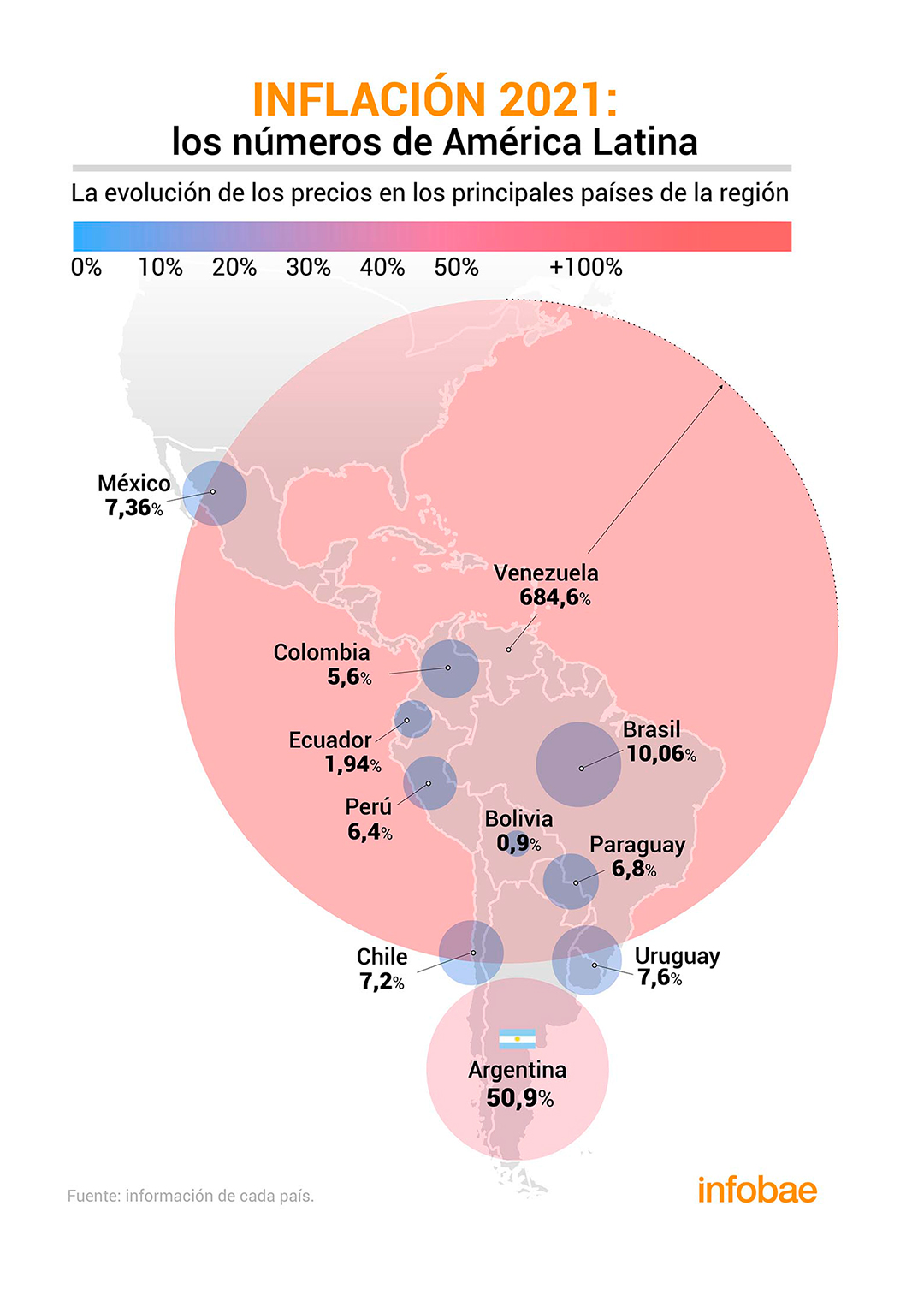
The alarming February Consumer Price Index (CPI) of 4.7% consolidated Argentina's proximity to the group of countries with the highest inflation rates in the world. President Alberto Fernández announced that “the war against inflation” is beginning, but his government has lost several battles that place the country still far from hyperinflation like the one that Venezuela is going through but close to having an unwanted global record.
4.7% in February, which represents 8.8% for the first two months of the year, is so high that it puts at early risk the 43% inflation pattern established in the agreement with the International Monetary Fund. In addition, there are two decisions included in that agreement that will have a direct impact on prices: the thawing of utility tariffs and the acceleration of the devaluation of the peso, which will no longer run back to inflation as happened in 2021.
The Market Expectations Survey (REM) carried out by the Central Bank places inflation for 2022 at 55%, above the official pattern agreed with the Fund and 52.3% year-on-year inflation in February. But at the same time there are other factors that push the upward outlook that add to what has already been mentioned, the impossibility of continuing to step on the dollar and tariffs. One of them is the 9% increase in fuels will generate “second-order increases”, as it will impact the distribution of many products. The rise in commodities generated by the Russian invasion of Ukraine, in particular of gas and oil, also predicts an impact on domestic prices through various avenues.
In this way, it is not surprising that the country ranks among the nations with the highest inflation globally. In 2001, there were only 4 countries in the world that had an inflation rate greater than 50.9 per cent in Argentina, according to estimates by the International Monetary Fund, out of a total of nearly 200 nations relieved by the multilateral organization.
The countries that surpassed Argentina last year were Venezuela, with 2,700% according to the IMF (although official country figures showed 686.4%, a slowdown from almost 3000% in 2021); Sudan, with 194.6%; Zimbabwe, with 92.5%; and Suriname, which registered 54.4%. These are nations that are going through scenarios of war conflicts, dictatorships and harsh internal crises.
Venezuela has been running out of inflationary control for years. In the midst of restrictions and problems in the supply of all kinds of products, the country emerged a few months ago from the hyperinflationary context it had been in since 2017. In December, the Central Bank of Venezuela (BCV) reported that its CPI was 7.6% and thus recorded 12 consecutive months with figures below 50% yoy, the number that is the threshold for hyperinflation.
Even with its chaotic economic and social situation, Venezuela's inflation in February was lower than in Argentina. It reached 2.9% and was the sixth consecutive month with single-digit inflation. Analysts see the main cause of the reduction in inflation in the appreciation of the bolivar against the dollar, the reduction of fuel subsidies and the easing of exchange control.
In Sudan (260%), meanwhile, the internal crisis is very strong after the military coup last October, which has since brought clashes with dozens of people killed in the streets and a food crisis that affects 70% of its population. Last week the Central Bank decided to completely liberate the foreign exchange market to try to stabilize the value of the Sudanese pound. Zimbabwe (66.1%), for its part, hit by the omicron variant of coronavirus and a growing level of political violence, fails to channel its economy after suffering for 30 years the dictatorship of Robert Mugabe that ended in 2017. Since then, inflation has been among the highest in the world.
Suriname (61.5%) aspires to control its inflation, projected a few percentage points above that of Argentina, after having sealed a three-year $688 million program with the IMF, with about $55 million in immediate disbursement. “The program aims to rebuild reserves,” said IMF managing director Kristalina Georgieva. The small country in northern South America, formerly known as Dutch Guiana, has just over half a million inhabitants.
World average and region
In the region, taking annual data for 2021 and with the exception already explained for Venezuela, Argentina's inflation rate stands out dramatically above the rest of the countries, even though several of them showed rising rates since the beginning of the pandemic. The only country with double-digit inflation was Brazil, which reached 10.06%, the highest in 6 years and doubling the target of 5.25%. In all other cases, Uruguay finished with 7.6%, Chile with 7.2%, Paraguay with 6.8%, Colombia with 5.6%, Ecuador with 1.94%, Bolivia with 0.9%, Peru with 6.4% (the highest in 13 years) and Mexico with 7.36%.

Last year inflation rose worldwide due to the effect of monetary issuance arising from government assistance programs to mitigate the effects of the coronavirus. World inflation averaged 4.3% — just below Argentina's monthly value yesterday — with an average of 5.5 percent for emerging countries and 2.8 percent for advanced economies.
KEEP READING:
Últimas Noticias
Debanhi Escobar: they secured the motel where she was found lifeless in a cistern

The oldest person in the world died at the age of 119

Macabre find in CDMX: they left a body bagged and tied in a taxi
The eagles of America will face Manchester City in a duel of legends. Here are the details

Why is it good to bring dogs out to know the world when they are puppies



